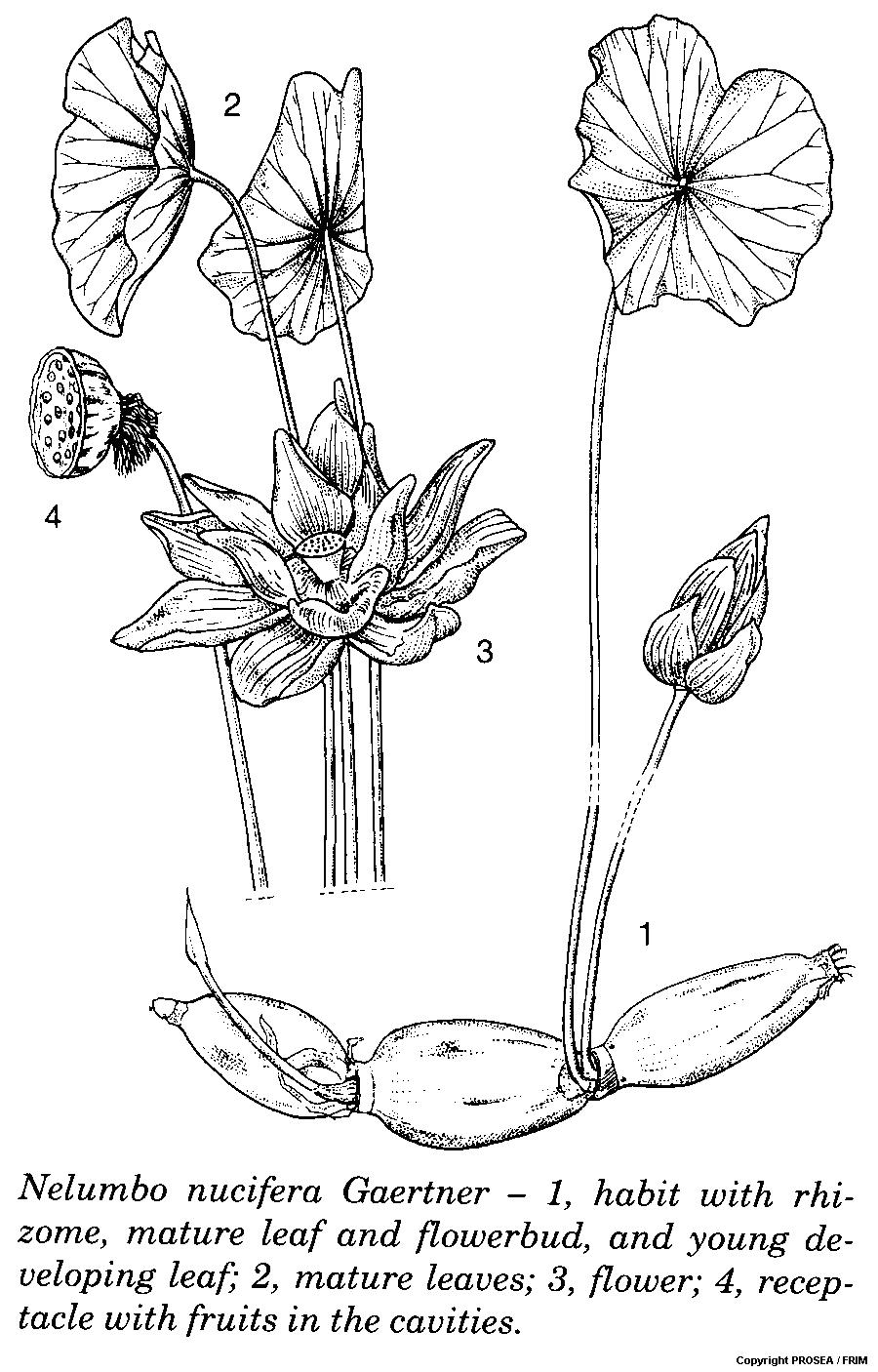Nelumbo nucifera Gaertner
Family
Nymphaeaceae
Synonyms
Nymphaea nelumbo L., Nelumbium speciosum Willd., N. nelumbo (L.) Druce.
Vernacular Names
| Malaysia | Seroja, padema, teratai. |
| English | Lotus, sacred lotus, Indian lotus. |
| Indonesia | Terate, seroja, padma. |
| Philippines | Baino (Tagalog), sukan (Bikol), sukaw (Ilokano). |
| Cambodia | Chhu:k. |
| Laos | Bwà. |
| Thailand | Bua-luang (General), ubon (Central), sattabut (Central). |
| Vietnam | Sen, hoa sen. |
| French | Lotus sacré. |
Geographical Distributions
Nelumbo nucifera originated from continental Asia (possibly India), but it is now widely distributed (wild or cultivated) from north-eastern Africa to north-eastern Australia, including Southeast Asia, China and Japan. For at least 6000 years, it has been associated with the Indian culture and religion as a sacred flower. It is also occasionally cultivated as an ornamental in Europe, Africa and America.
Description
N. nucifera is a large, perennial, glaucous, hairless, aquatic herb that can reach up to 1.2-2.5 m tall, contains milky latex and roots in the substrate (usually mud). The rhizomes are creeping, jointed, measure up to 10 m long, measuring 6-9 cm in diametre, with ellipsoidal interjoints which measured 10-30 cm long, white to light brown, fleshy, mucilaginous and slightly fibrous.
The leaves are with peltate that arise from the joints which are one leaf per joint. The petiole is cylindrical, measures up to 2.5 m long, covered with short fleshy prickles and inside with numerous air canals. The blade is depressed orbicular or shallowly cup-shaped, measuring up to 90 cm or more in diametre, entire, glaucous above, purplish beneath and raised above the water.
The flowers are solitary, axillary, projecting above the water higher or as high as the leaves, erect or nodding, measuring 15-25 cm in diametre, fragrant, pink with a white base and rarely entirely white. The pedicel is erect, cylindrical, measures up to 2 m long or longer and prickly like the petiole. There are 2-5 sepals, measuring up to 2.5 cm x 2 cm and fall off before anthesis. There are about 20 petals which are unequal, obovate, measuring up to 7-15 cm x 3-7 cm and inserted at the base of the receptacle. The outer ones are smallest and the intermediate ones are largest while the innermost ones are medium-sized. The stamens are numerous, inserted immediately above the petal, with linear filaments, measure up to 2.5 cm long and with yellow anthers. The receptacle is obconical with a flat apex, measuring 2-4 cm x 3-4 cm, spongy, yellow at anthesis, turns green to finally black-brown and measuring 6-11 cm in diametre. There are 10-30 ovaries that are wide apart, sunken in the apex of the receptacle, free and uniovulate. The style is short and with a thickened stigma.
The fruit is an aggregate of indehiscent nutlets. The nutlets are 10-30 per aggregate fruit, ovoid-oblongoid, measuring 1-2.5 cm x 1-1.5 cm and black-brown.
The seed is with one bifid cotyledon and endosperm that envelop the embryo as a thin membrane.
Ecology / Cultivation
The natural habitat for N. nucifera is freshwater bodies in the tropical and subtropical Asia. N. nucifera grows in old mining pools, natural or man-made lakes, canals and ponds. Because the rhizomes lie deep in the mud underwater, they are beyond the reach of frost that would kill them. Therefore, it is widely distributed in Asia even in the regions not free from frost. It occurs from sea level up to 1800 m altitude.
Line Drawing / Photograph
References
- Plant Resources of South-East Asia No. 9: Plants yielding non-seed carbohydrates.



